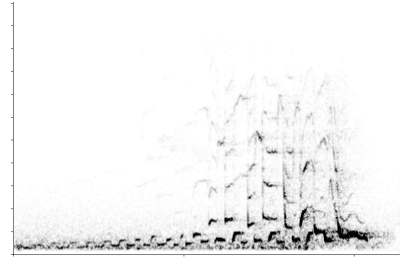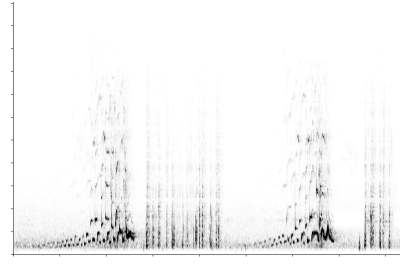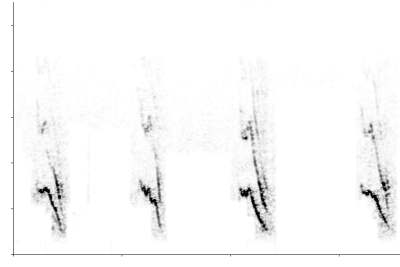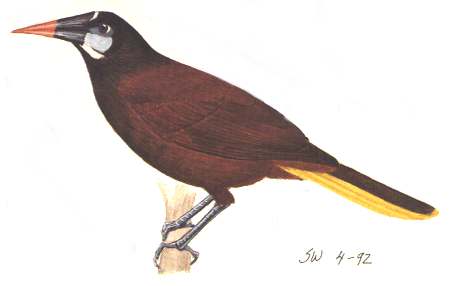

Click on spectrogram to download sound file
Last two songs from sound file depicted
Click on spectrogram to download sound file

Click on spectrogram to download wav file

![]()
Song Description:
The strange and remarkable song of the Montezuma Oropendola is an ascending series of overlapping bubbly syllables which crescendo to a high peak. The song is often accompanied by a scratchy call that is reminiscent of a fizzling firecracker or the ripping of a thick fabric (Stiles & Skutch 1989). A single-syllable whiney eeuh call seems to function as a contact call between birds. Howell and Webb (1995) report other calls including "a squeaky woik, a low chuck..., a gruff sneezy rruh, [and] a cooing, slightly clucking kyuk kyuk."
![]()
Song Measures:
The Montezuma Oropendola's song is complex and difficult to describe. It often begins with a very quiet series of similar syllables which rise from 250 Hz to 900 Hz. This introductory portion of the song is often truncated, but may be as long as 1.5 seconds. The remainder of the song is a series of overtone-rich overlapping syllables most of which are upslurred. The total song lasts between 0.75 and 2.0 seconds and often rises to a maximum frequency of > 8000 Hz. The terminal syllable is a longer downslurred note and is usually the loudest part of the song (N = 50 songs from many different birds).
The firecracker call is often given immediately after a song, but is sometimes given on its own. It is produced by the bird inflating its furcular air sac; the calling bird visibly deflates as the vocalization progresses. This call contains a series of rapid pulses and may continue for as long as five seconds (N = 12 calls from > two birds).
The short contact call (0.25 ± 0.04 seconds) is a single downslurred note falling from 1500 to 500 Hz. The inter-call interval is 1.70 ± 0.36 seconds and the contact call is often repeated at this rate for tens of minutes (N = two long calling bouts).
![]()
Singing Behaviour:
While Howell and Webb (1995) suggest Montezuma Oropendolas are found "singly or in small groups," I observed a highly vocal mixed-sex flock of at least 50 birds moving through the Calakmul Biosphere Reserve over a period of three days. This noisy flock sang at all times of the day and could be heard from very far away. All vocalizations described here were only given when birds were perched, although some short, gruff syllables were given in flight. The contact call was most often given back and forth between two isolated birds who were perched at far ends of a fig tree in which they were feeding.
![]()
Habitat:
These arboreal birds were found in the thick humid forests in Calakmul, often alighting very high in large trees with a semi-open canopy along paths or at forest edges.
![]()
Return
to Bird Songs of the Yucatan Main Page
All
information and photographs copyright Daniel J. Mennill 1999.
No recordings or other information from this site may be used without
written permission from me.
Please email me (dmennill AT
uwindsor DOT ca) and I will happily grant permission for any
non-commercial or education purposes.